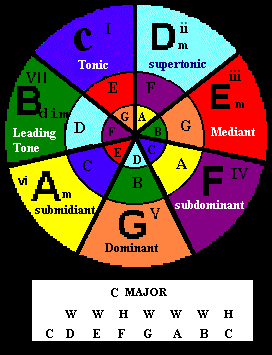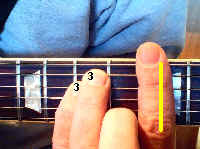|
      
Chords, Constructing Arpeggios and Scale
Relationship
 |
 | The chord to the left is the
Root 6 bar chord. It is determined by the note played on the Low E
string or 6th string. It is also at times called an E type bar chord,
this is because the E chord can be converted to the E bar chord. For our
examples, I will be explaining this chord played at the fifth fret. |
 | This
movable bar chord when played at the 5th fret, would be the A Major
Chord. By raising the middle finger, this would now be the Am chord.
Look at the Am chord below. This is played at the 5th fret index finger. |
|
Understanding the relationship to chords
over scales and arpeggios
I would now like to show you how to build Arpeggios. An Arpeggio is
when you pick each note of a chord one note at a time. A chord is when
all of the notes of the chord are strummed together. You can learn to
build melodies and construct songs, using arpeggios. The first arpeggio
we will construct will be the Am chord at the root note fret or
5th fret. The picture above illustrates that chord.
 |
 | Look at the
illustration to the left. This is the root 6, Am bar chord played at the 5th fret.
The notes that make up the Am chord are A, C and E. Look at the next
illustration to the left, notice all the notes of the Am chord are
illustrated. |
|
 |
 | Notice how all the
notes illustrated are the notes of the Am chord. Now look at the next
illustration below. |
|
 |
 | The illustration to
the left shows how to use the notes of the Am chord to play as an
arpeggio. Start on the A note, 5th fret Low E
string. Then play each note in the number sequence. |
|
 |
 | The illustration to the left
should be really familiar to you by now. But once again, I will explain
what is going on. The outer circle to the left shows all of the chords
of the key of C major. Each section shows the notes of each chord. |
 | Each of the chords in this section are called triads. A triad is a
chord that is made up of three notes. Each of the chords in the key of C
major are illustrated. |
 | Look to the left and notice the C chord. The three notes that make up
the C chord are the C, E and G notes. |
 | Notice the notes that make up the Am chord. These three notes are A,
C and E. These will be the three notes we will use to play are first
arpeggio. We will begin our arpeggio at the root note fret of the Am
pentatonic scale and eventually learn them in other positions. |
|
 |
 | This illustration shows you how to
play an arpeggio over the root 6 Am bar chord. It is located over the Am
pentatonic scale, root note fret. You should be very familiar with the Am
pentatonic root note fret by now. |
|
To use the illustration above, you would start on the A
note, fifth fret, Low E string. Pick that
note with your 1 finger. The next note is played at the 8th fret, Low
E string C note, play that note with your 4 finger. The next note
is played at the 7th fret, A string, E
note. Play that note with your 3 finger. The next note is played at the
7th fret, D string, A note. Use your 3
finger. The next note is played at the 3rd fret, G
string, C note. Use your 1 finger. The next note is played at the
5th fret, B string E note. Use your 1
finger. The next note is played at the 5th fret, high E
string, A note.
Use your 1 finger. The next note is played at the 8th fret, high
E string, C note. Use your 4 finger. Once your reach the last
note, reverse the process and work your way back to the A note, Low
E string, 5th fret.
What I want to do is show you how to play every
chord and arpeggio over the Am pentatonic root note position. The chords
we will learn will be, The C, Dm, Em, F, G, Am and the B diminished chords
and arpeggios.
 | Before we do that, we must go learn the C Ionian major scale. So, go read up on this scale and we will begin to advance on our
theory. |
Good luck,
From the Jam Room
|



 Compare
the fingering of the Am bar chord to the left to the illustration
above. Notice how this chord fits over the Am pentatonic scale.
Compare
the fingering of the Am bar chord to the left to the illustration
above. Notice how this chord fits over the Am pentatonic scale.











